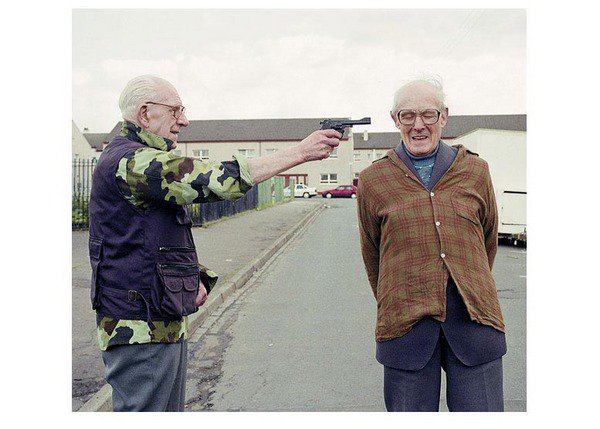Concept after Concept
dal 7/5/2014 al 27/9/2014
Segnalato da
Art & Language
John Baldessari
Björnligan
General Idea
Andrea Büttner
Anna-Bella Geiger
Henriette Heise
Henry VIII’s Wives
Inspection Medical Hermeneutics
Kristine Kemp
Koncern°
Louise Lawler
Emil Lykkegaard
Albert Mertz
Présence Panchounette
Kirsten Pieroth
Michael Portnoy
Lasse Schmidt Hansen
7/5/2014
Concept after Concept
Museum of Contemporary Art, Roskilde
Before Normal. In the exhibition, conceptual art isn't understood as the moment when art began to produce meaning, but also as resistance to meaning: the movement towards dissolution and the desire for clashes of information that take it well beyond the power moves of the art world. Works by Art & Language, John Baldessari, Inspection Medical Hermeneutics, Emil Lykkegaard, Lasse Schmidt Hansen among others.

Curated by Lars Bang Larsen
Art & Language (UK), John Baldessari (US), Björnligan (S) General Idea (CAN), Andrea Büttner (D), Anna
Bella Geiger (BRA), Henriette Heise (DK), Henry VIII’s Wives (UK/N/DK), Inspection Medical Hermeneutics
(RUS), Kristine Kemp (DK), Koncern° (DK), Louise Lawler (US), Emil Lykkegaard (DK), Albert Mertz (DK),
Présence Panchounette (F), Kirsten Pieroth (D), Michael Portnoy (US), Lasse Schmidt Hansen (DK)
Art in the form of trenchcoat paintings, Kermit cakes, an erudite French garden gnome, a Viking ship,
cosmic mathematics with IKEA-bookshelves, holes in the ground, psychedelic Christmas plates, famous
male artists’ names as bird calls...
What do we mean when we talk about conceptual art? Are its history and potential adequately
understood?
Conceptualism is generally taken to be a remote and intellectual art form that avoids images and visuality,
valorising text, language and information instead: the super-ego of visual arts that insists on the last word
and the right to judge all other art. The logocentric cliché that ‘the idea in itself’ forms the conceptualwork continues to be reiterated. Contrary to prejudices against conceptualism as a rigid and analytical art
form, Concept After Concept presents conceptual works that embrace – as they always have - laughter and
active nihilism.
In the exhibition, conceptual art isn’t understood as the moment when art began to produce meaning, but
also as resistance to meaning: the movement towards dissolution and the desire for clashes of information
that take it well beyond the power moves of the art world. Resisting both aestheticism and theory with
ironic (self) critique and geeky sensuality, conceptualism was and is also cultural critique and an acid bath
for rationality.
Perhaps conceptualism always needed an enemy. In the conceptual art of the 1960s, it was the art
object, the myth of the artistic genius, or the idea of spontaneous creativity. More ambiguously, this
enemy could even be conceptualism itself, as when John Baldessari sang Sol LeWitt’s manifesto ’Sentences
on Conceptual Art’ (Baldessari Sings LeWitt,
1972). It wasn’t only a question of abolishing
tradition: scepticism became self-scepticism,
and was directed against any activity claiming
the name of art in a radical critique of the art
concept and its location within a modern
cultural economy.
As a contradictory phenomenon that includes
play and confrontation, irony and analysis,
conceptualism’s inner tensions can extend or be
exacerbated to embrace an aesthetic death drive
that has the potential to detonate the individual artist. In this context, the phenomenon of artist groups,
in which the individual signature is subsumed by collective identity, testifies to a structural method to
undermine the conventional singular, identitarian forms of Artist, Medium and Art Work.
Perhaps paradoxically, conceptual art also displays populist
traits. The work is often a joke on itself, on symbolic
authority, and on processes of authorization. There is, or was,
also a tendency for artists to orient themselves in the
direction of popular culture and cultural specificity, imbuing
global conceptualism with national signifiers or even anti-
cosmopolitan embodiments of the parochial.
By focusing on under-theorized aspects of conceptual art, and
sampling works from a range of generations and geopolitical
contexts, Concept After Concept seeks to present evidence
that conceptualism - then and now - has a greater aesthetic
potential than usually assumed. The exhibition takes part ofits title from Kristine Kemp’s work Before Normal (2013), indicating the continued role of conceptualism
in breaking with normality in the face of the instrumentalisation of art.
Kindly supported by The Novo Nordisk Foundation, The Danish Arts Council, The Danish Agency for
Culture, The Danish Arts Foundation, OCA - Office for Contemporary Art Norway, The L.F. Foght
Foundation, and L. Zeuthen’s Memorial Foundation.
Image: Henry VIII's Wives, Assasination of a Vietcong - Iconic Moments of the Twentieth Century, 2007
For more information please contact:
Sanne Kofod Olsen, Director
Museum of Contemporary Art
Stændertorvet 3D, 4000 Roskilde
Denmark
sannekol@samtidskunst.dk
T+45 46316572
Opening: May 8th, 5-7pm
Museum of Contemporary Art
Stændertorvet 3D - DK-4000 Roskilde
Opening hours: Tuesday–Sunday, 12-5pm
Admission:
Adults: 40 DKK
Senior citizens and students: 20 DKK
Children under the age of 18: Free entrance
Members of Klub Samtidskunst and other memberships: Free entrance
Visits to the museum in an educational context or as a group of students are free during extended opening hours.
Please note that reservations must be made in advance.



